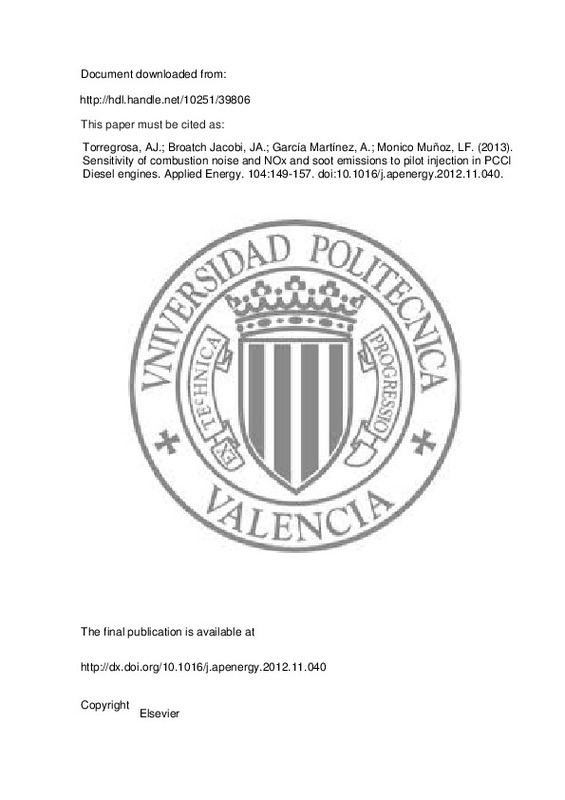JavaScript is disabled for your browser. Some features of this site may not work without it.
Buscar en RiuNet
Listar
Mi cuenta
Estadísticas
Ayuda RiuNet
Admin. UPV
Sensitivity of combustion noise and NOx and soot emissions to pilot injection in PCCI Diesel engines
Mostrar el registro sencillo del ítem
Ficheros en el ítem
| dc.contributor.author | Torregrosa, A. J.
|
es_ES |
| dc.contributor.author | Broatch Jacobi, Jaime Alberto
|
es_ES |
| dc.contributor.author | García Martínez, Antonio
|
es_ES |
| dc.contributor.author | Mónico Muñoz, Luisa Fernanda
|
es_ES |
| dc.date.accessioned | 2014-09-22T09:12:15Z | |
| dc.date.available | 2014-09-22T09:12:15Z | |
| dc.date.issued | 2013-04 | |
| dc.identifier.issn | 0306-2619 | |
| dc.identifier.uri | http://hdl.handle.net/10251/39806 | |
| dc.description.abstract | Diesel engines are the most commonly used internal combustion engines nowadays, especially in European transportation. This preference is due to their low consumption and acceptable driveability and comfort. However, the main disadvantages of traditional direct injection Diesel engines are their high levels of noise, nitrogen oxides (NO x) and soot emissions, and the usage of fossil fuels. In order to tackle the problem of high emission levels, new combustion concepts have been recently developed. A good example is the premixed charge compression ignition (PCCI) combustion, a strategy in which early injections are used, causing a burning process in which more fuel is burned in premixed conditions, which affects combustion noise. The use of a pilot injection has become an effective tool for reducing combustion noise. The main objective of this paper is to analyze experimentally the pollutant emissions, combustion noise, and performance of a Diesel engine operating under PCCI combustion with the use of a pilot injection. In addition, a novel methodology, based on the decomposition of the in-cylinder pressure signal, was used for combustion noise analysis. The results show that while the PCCI combustion has potential to reduce significantly the NO x and soot emission levels, compared to conventional Diesel combustion strategy, combustion noise continues to be a critical issue for the implementation of this new combustion concept in passenger cars. | es_ES |
| dc.description.sponsorship | This work has been partially supported by Ministerio de Educacin y Ciencia through Grant No. TRA2006-13782. L.F. Monico holds the Grant 2009/003 from Santiago Grisolia Program of Generalitat Valenciana. | en_EN |
| dc.language | Inglés | es_ES |
| dc.publisher | Elsevier | es_ES |
| dc.relation.ispartof | Applied Energy | es_ES |
| dc.rights | Reserva de todos los derechos | es_ES |
| dc.subject | PCCI combustion | es_ES |
| dc.subject | Combustion noise | es_ES |
| dc.subject | Pollutant emissions | es_ES |
| dc.subject | Diesel engine | es_ES |
| dc.subject | Pilot injection | es_ES |
| dc.subject.classification | MAQUINAS Y MOTORES TERMICOS | es_ES |
| dc.title | Sensitivity of combustion noise and NOx and soot emissions to pilot injection in PCCI Diesel engines | es_ES |
| dc.type | Artículo | es_ES |
| dc.identifier.doi | 10.1016/j.apenergy.2012.11.040 | |
| dc.relation.projectID | info:eu-repo/grantAgreement/MEC//TRA2006-13782/ES/ESTUDIOS PARA LA REDUCCION DEL NIVEL Y LA MEJORA DE LA CALIDAD SONORA DEL RUIDO DE COMBUSTION EN MOTORES HCCI/ | es_ES |
| dc.relation.projectID | info:eu-repo/grantAgreement/GVA//GRISOLIA%2F2009%2F003/ES/GRISOLIA%2F2009%2F003/ | es_ES |
| dc.rights.accessRights | Abierto | es_ES |
| dc.contributor.affiliation | Universitat Politècnica de València. Departamento de Máquinas y Motores Térmicos - Departament de Màquines i Motors Tèrmics | es_ES |
| dc.description.bibliographicCitation | Torregrosa, AJ.; Broatch Jacobi, JA.; García Martínez, A.; Mónico Muñoz, LF. (2013). Sensitivity of combustion noise and NOx and soot emissions to pilot injection in PCCI Diesel engines. Applied Energy. 104:149-157. https://doi.org/10.1016/j.apenergy.2012.11.040 | es_ES |
| dc.description.accrualMethod | S | es_ES |
| dc.relation.publisherversion | http://dx.doi.org/10.1016/j.apenergy.2012.11.040 | es_ES |
| dc.description.upvformatpinicio | 149 | es_ES |
| dc.description.upvformatpfin | 157 | es_ES |
| dc.type.version | info:eu-repo/semantics/publishedVersion | es_ES |
| dc.description.volume | 104 | es_ES |
| dc.relation.senia | 233002 | |
| dc.contributor.funder | Ministerio de Educación y Ciencia | es_ES |
| dc.contributor.funder | Generalitat Valenciana | es_ES |







![[Cerrado]](/themes/UPV/images/candado.png)

